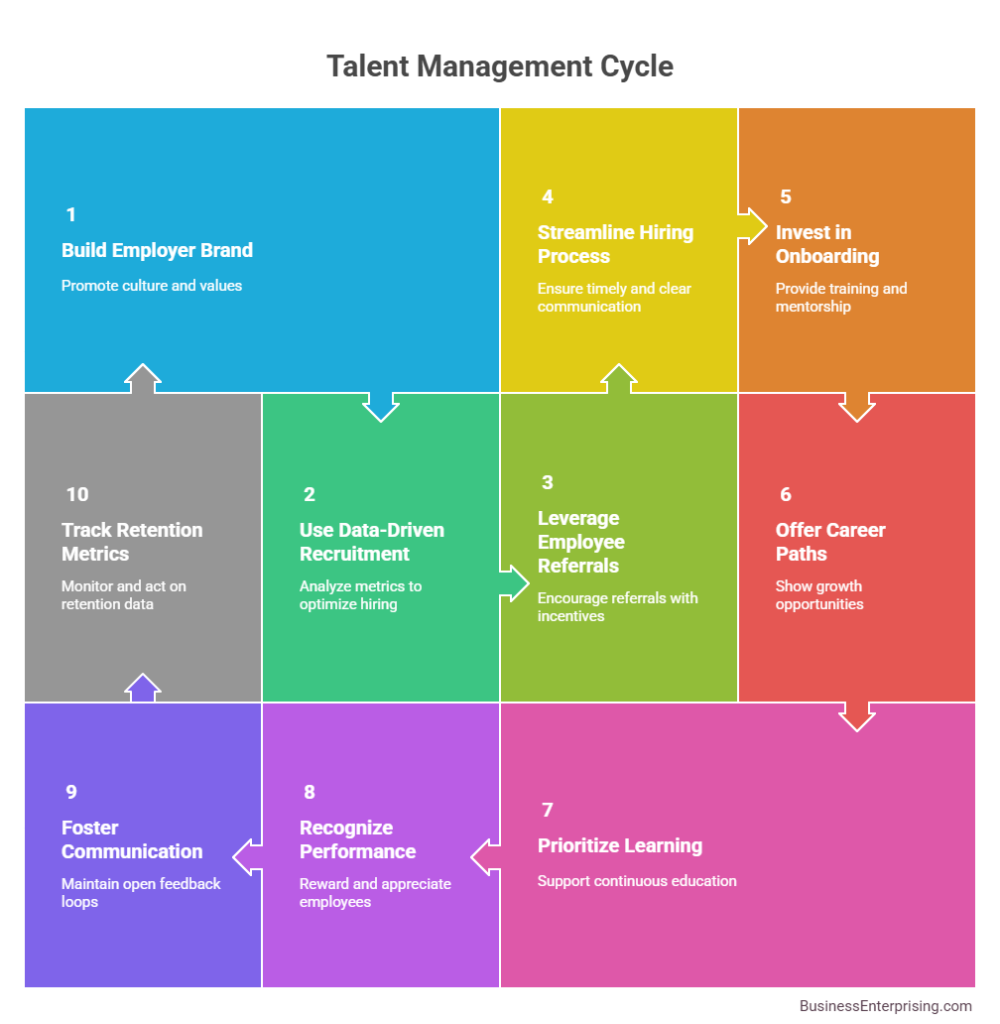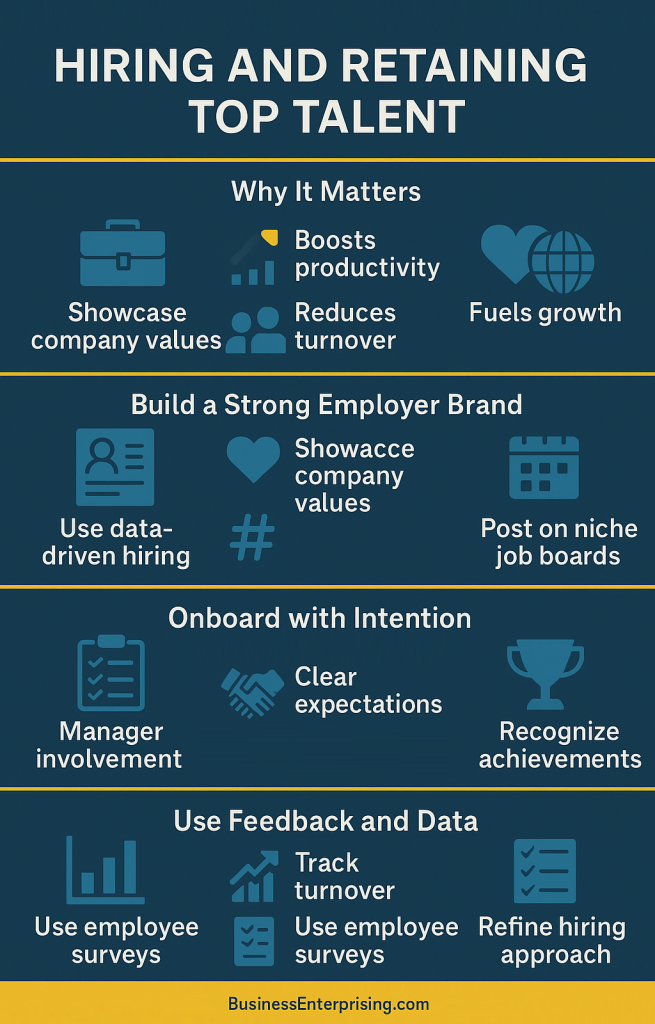
Also, keeping great employees is just as important. Once you’ve hired well, your focus must shift to retention. If your team feels ignored or unsupported, they won’t stay long. As a result, you’ll waste time replacing people who never should have left. Therefore, your strategy should cover every stage of the employee experience. From branding to onboarding to growth, each part plays a role. When those pieces work together, your business benefits from stability, loyalty, and stronger performance.
You don’t need big budgets to compete. Instead, focus on clarity, respect, and consistent communication. That’s what most people value. And that’s what keeps them with you long term. Also, using feedback and tracking results helps improve your process over time. Small changes can make a big difference. By paying attention to what works, you build a system that brings in better talent and keeps them on your team.
The Business Impact of Top Talent
High-performing employees are your company’s most valuable asset. They get more done, solve problems faster, and push your business forward. When your team includes people who are skilled, focused, and motivated, your company operates more efficiently across the board.
Additionally, top talent often introduces new ideas and better ways of working. Their contributions lead to better products, smoother systems, and stronger team performance. Because they consistently go beyond the basics, your business stays competitive and responsive to change. Therefore, when you focus on hiring and retaining top talent, you create long-term value. You don’t just fill a position—you invest in productivity. These employees require less supervision and often take initiative, which frees up time for you and your leadership team.
However, hiring the right people is only half the work. Keeping them engaged, supported, and challenged helps them stick around. Otherwise, you risk losing them to competitors who offer better growth opportunities or work environments. Retention efforts pay off by reducing hiring costs and preserving institutional knowledge. Also, a strong team boosts morale across the company. People want to work with others who are capable and committed. This creates a more focused and motivated workplace culture. As a result, overall performance improves naturally.
Top employees help set the standard. Others often rise to meet it. Because of this, your entire organization benefits. Every hire has the potential to affect your bottom line—for better or worse. Therefore, being intentional about talent acquisition and retention is not just smart. It’s necessary for lasting growth.
Crafting an Attractive Employer Brand
If you want better candidates, you need to be a better company to work for. People notice how you treat employees. They also notice what your current team says about working for you. This is why your employer brand matters. Additionally, your company culture tells a story. It shows how people interact, how decisions are made, and how success is recognized. If your culture is toxic or unclear, top talent will walk away. However, when people feel respected, included, and supported, they’re more likely to stay.
Your values also play a role. People want to work for companies that reflect their own beliefs. Therefore, be clear about what you stand for and how you operate. You don’t need to appeal to everyone, but you should be consistent.
Your online presence gives candidates a preview. They check your website, your job listings, and your social media profiles. If those channels look dated or feel disconnected, candidates may move on. Therefore, keep your messaging up to date and aligned with your internal culture.
Also, use real voices when sharing content about your company. Authentic employee stories and photos go further than polished slogans. They make your company feel human. As a result, you attract people who are a better fit for your team.
Hiring and retaining top talent takes more than good pay. It starts with how people see your company. By building an authentic and positive employer brand, you make it easier to attract the right people and keep them for the long haul.
Effective Recruitment Strategies
Recruiting has changed. You can no longer rely on a single job post to attract the right people. Instead, use a combination of modern strategies to reach better candidates faster. Additionally, data-driven recruiting helps you spot patterns. It shows what sources bring strong applicants and where bottlenecks occur. You can then focus time and money where they make the most impact. This improves both speed and quality.
Employee referrals still work well. People tend to recommend candidates who fit your culture and can perform. Therefore, offer a clear referral process and reward employees for quality leads. It’s a simple way to expand your reach.
Social media also plays a big role. Many job seekers check company pages before applying. However, posting jobs isn’t enough. Use social channels to share your culture and daily work life. This builds interest and trust over time.
Niche job boards are another option. These platforms attract professionals who already work in your industry. As a result, you spend less time screening unqualified candidates. The focus shifts to interviewing better matches.
Hiring and retaining top talent starts with finding them in the right places. Modern recruiting requires ongoing effort. You need to track what works, test new approaches, and adjust your message. That’s how you build a strong hiring system that delivers results.
The Role of Onboarding in Retention
Onboarding sets the tone for everything that follows. New hires form lasting impressions during their first days. How you handle this matters. If your process is unorganized or unclear, new employees may quickly lose confidence. However, when onboarding is structured and thoughtful, people feel welcome and prepared. They know what’s expected and how to get support. This builds early momentum and reduces confusion. Additionally, good onboarding improves engagement. People who understand their role and your culture tend to get involved faster. As a result, they become productive sooner and feel more connected to the team.
Turnover is often highest in the first few months. Therefore, giving new hires a solid foundation lowers the chance they’ll leave early. You invest time upfront to avoid bigger losses later. Also, onboarding is more than paperwork. It should include training, introductions, and time with managers. When people feel seen and supported, they stick around longer.
Hiring and retaining top talent takes more than a good interview. It continues on day one and every day after. Therefore, your onboarding process should be consistent, simple, and aligned with how you run your business. You don’t need a long checklist to make a difference. Instead, focus on clarity, communication, and connection. When you do that, you turn new hires into long-term employees.
Building a Culture of Engagement and Growth
People don’t just want a paycheck—they want purpose and progress. If your company doesn’t support growth, employees won’t stay long. This is where culture makes the difference. When people feel challenged and appreciated, they’re more likely to stay committed. Additionally, continuous learning keeps your team sharp. It helps people adapt to change and stay engaged. You don’t need to offer big programs. Instead, focus on access to tools, resources, and simple ways to build skills.
Career development also matters. People want to see a path forward. Therefore, talk with your team about goals and growth options. Even small steps in the right direction build long-term loyalty. However, growth alone isn’t enough. People also want to be recognized. You don’t need elaborate rewards. A thank-you or a small gesture often goes further than you think. Also, a culture of feedback creates progress. When people know how they’re doing and where they can improve, they stay motivated. As a result, your team performs better and feels more connected to their work.
Hiring and retaining top talent means giving people reasons to stay. A strong culture offers more than perks. It offers growth, value, and the chance to contribute in meaningful ways. Therefore, if you want to reduce turnover, build a place where people can learn, grow, and feel recognized. That’s what turns good employees into long-term contributors.
Using Data and Feedback to Improve Hiring and Retention
You can’t fix what you don’t measure. If you want better hiring results, you need to track what’s working and what’s not. Without data, you’re making guesses. That’s risky when the goal is long-term growth. Additionally, turnover rates tell you a lot. If people are leaving quickly, something is off. It could be the role, the manager, or the work environment. Therefore, reviewing exit data helps you spot patterns and take action early.
Employee surveys are also helpful. However, you need to ask direct questions and actually use the answers. When people feel heard, they speak honestly. As a result, you get clear input that helps shape your culture and policies. Performance data matters too. If certain hires succeed faster, look at what they have in common. Then, use those traits to guide future recruiting decisions. That way, you improve both quality and fit. Also, make it a habit to review your hiring sources. Some channels may bring better candidates than others. Therefore, shift your efforts based on results, not assumptions.
Hiring and retaining top talent isn’t guesswork. It’s an ongoing process that depends on feedback and tracking. The more you learn, the more you improve. Therefore, use the data you already have. Combine it with real conversations and clear goals. That’s how you build a strategy that works.
Conclusion
Hiring and retaining top talent takes focus, consistency, and the right systems. You need more than a good offer to keep people. However, when you build a strong brand and a structured hiring process, results improve. Additionally, the first days on the job matter more than many realize. New hires form fast opinions about your company and culture. Therefore, make onboarding clear, thoughtful, and useful from day one.
You should also think long-term. Growth, recognition, and support make a big difference in how long people stay. When your team feels valued and sees a future, they’re more likely to stay committed. However, you can’t rely on guesswork. Use feedback and performance data to refine your approach. Look at what’s working, and adjust what’s not. This helps you build better systems over time. Also, remember that top performers often have options. They want a place where they can succeed and grow. Therefore, you must create an environment that supports those goals.
Hiring and retaining top talent isn’t a single task. It’s an ongoing effort that requires attention and care. But the payoff is worth it. When you have the right people in place, your entire business benefits. Make the effort to get hiring right. Then follow through with support, development, and honest communication. That’s how you keep good people around.



